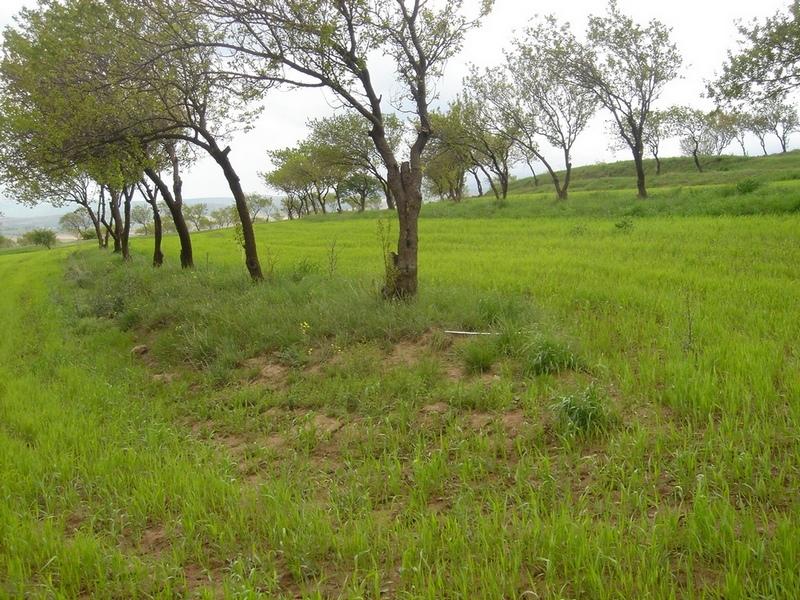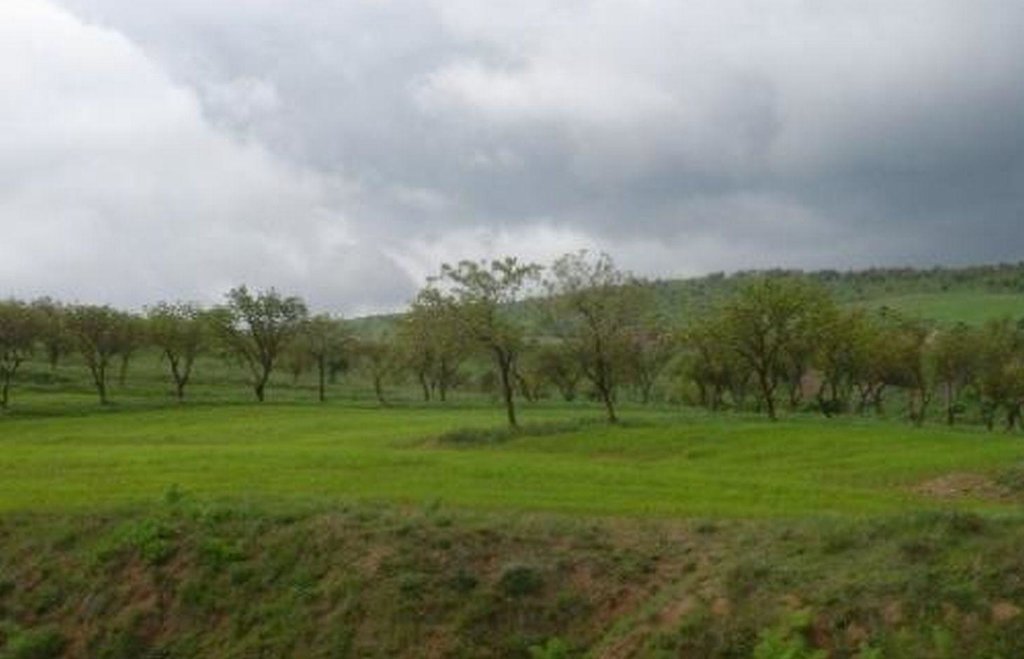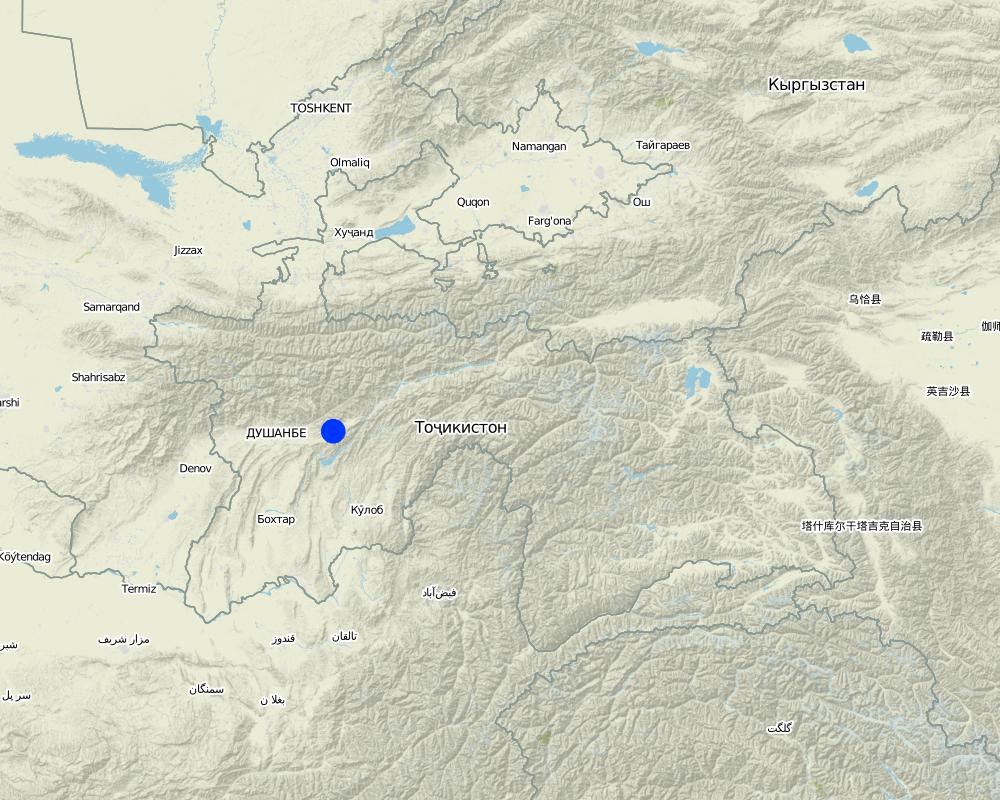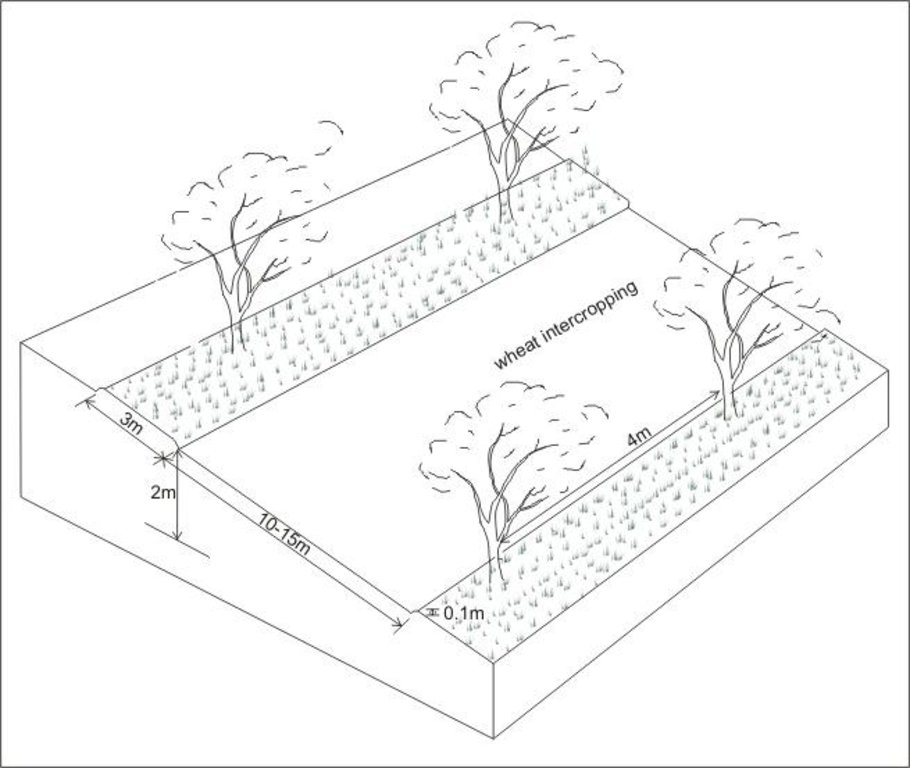Orchard-based Agroforestry (intercropping) [Tajikistan]
- Creation:
- Update:
- Compiler: Erik Bühlmann
- Editor: –
- Reviewers: Alexandra Gavilano, David Streiff
technologies_1002 - Tajikistan
- Full summary as PDF
- Full summary as PDF for print
- Full summary in the browser
- Full summary (unformatted)
- Orchard-based Agroforestry (intercropping): Nov. 2, 2021 (public)
- Orchard-based Agroforestry (intercropping): Aug. 20, 2019 (inactive)
- Orchard-based Agroforestry (intercropping): July 19, 2017 (inactive)
- Orchard-based Agroforestry (intercropping): July 17, 2017 (inactive)
- Orchard-based Agroforestry (intercropping): March 10, 2017 (inactive)
View sections
Expand all Collapse all1. General information
1.2 Contact details of resource persons and institutions involved in the assessment and documentation of the Technology
SLM specialist:
Name of the institution(s) which facilitated the documentation/ evaluation of the Technology (if relevant)
CDE Centre for Development and Environment (CDE Centre for Development and Environment) - SwitzerlandName of the institution(s) which facilitated the documentation/ evaluation of the Technology (if relevant)
NCCR North-South (NCCR North-South) - Kyrgyzstan1.3 Conditions regarding the use of data documented through WOCAT
The compiler and key resource person(s) accept the conditions regarding the use of data documented through WOCAT:
Yes
2. Description of the SLM Technology
2.1 Short description of the Technology
Definition of the Technology:
Intercropping of wheat in an existing orchard that was established during the Soviet period.
2.2 Detailed description of the Technology
Description:
The technology involves intercropping wheat in an existing apricot orchard, that was established during soviet times to increase farm production, by integrating different resources in an environment protected from soil erosion. The intercropped area is ploughed by tractor. In general, farmers do not practice crop rotation since they usually allocate cereal production to the most fertile field plots of their farm.
Along the trees aligned on contour, a three metre wide grass strip is left uncultivated to control runoff, and to protect the ground from splash erosion. Spacing between rows is 13 metres, which allows unhindered farm operations.
Most orchards in Faizabad Rayon were established during Soviet times. Tree rows were planted close together in order to obtain maximum yields from the orchard monoculture systems. Some of the tree rows were removed, allowing more space for intercropping.
Purpose of the Technology: The technology is applied in existing orchards which generally range between 10-25% in gradient. In existing orchards, intercropping alone is relatively cost intensive. Harvesting two crops at a time increases overall farm production and improves food security since harvests of intercropped food crops are found to be more reliable than those on exposed annual cropland. However, many orchards are still owned by state farms which usually do not practice intercropping. Since management of fruit trees require considerable labour and material inputs (e.g. chemicals for pest/disease control as well as fertilisers) which often cannot be met by farmers, yields of fruit trees have declined after the privatisation of these areas. Furthermore, farmers often lack knowledge of appropriate orchard management techniques and miss opportunities to gradually replace old trees by new seedlings.
2.3 Photos of the Technology
2.5 Country/ region/ locations where the Technology has been applied and which are covered by this assessment
Country:
Tajikistan
Region/ State/ Province:
Tajikistan
Further specification of location:
Faizabad Rayon
Specify the spread of the Technology:
- evenly spread over an area
If precise area is not known, indicate approximate area covered:
- 1-10 km2
Map
×3. Classification of the SLM Technology
3.1 Main purpose(s) of the Technology
- improve production
3.2 Current land use type(s) where the Technology is applied
Land use mixed within the same land unit:
Yes
Specify mixed land use (crops/ grazing/ trees):
- Agroforestry

Cropland
- Annual cropping
- Perennial (non-woody) cropping
- Tree and shrub cropping
Annual cropping - Specify crops:
- legumes and pulses - peas
- fibre crops - flax, hemp, other
- cereals - wheat (spring)
- fodder crops - other
- fodder crops - alfalfa
- esparzet
Tree and shrub cropping - Specify crops:
- fruits, other
- stone fruits (peach, apricot, cherry, plum, etc)
Is intercropping practiced?
Yes
Comments:
Major land use problems (compiler’s opinion): severe water erosion (rills and gullies) and subsequent fertility decline on cropland and overgrazed pastures
Major land use problems (land users’ perception): fertility decline, soil erosion and washing downslope of seeds before they can sprout
Type of cropping system and major crops comments: Intercropped winter wheat and sometimes chickpeas are sown in autumn; flax, alfa alfa, esparzet, and also chickpeas are sown in early spring
3.3 Has land use changed due to the implementation of the Technology?
Has land use changed due to the implementation of the Technology?
- Yes (Please fill out the questions below with regard to the land use before implementation of the Technology)

Cropland
Is intercropping practiced?
Yes
If yes, specify which crops are intercropped:
Intercropping of wheat between apricot trees aligned on contour
3.4 Water supply
Water supply for the land on which the Technology is applied:
- rainfed
3.5 SLM group to which the Technology belongs
- agroforestry
3.6 SLM measures comprising the Technology

agronomic measures
- A1: Vegetation/ soil cover
- A7: Others

vegetative measures
- V5: Others

management measures
- M1: Change of land use type
Comments:
Main measures: agronomic measures
Secondary measures: vegetative measures
Type of agronomic measures: mixed cropping / intercropping, mineral (inorganic) fertilizers, contour tillage
Type of vegetative measures: aligned: -contour
3.7 Main types of land degradation addressed by the Technology

soil erosion by water
- Wt: loss of topsoil/ surface erosion
- Wg: gully erosion/ gullying

chemical soil deterioration
- Cn: fertility decline and reduced organic matter content (not caused by erosion)
Comments:
Main type of degradation addressed: Wt: loss of topsoil / surface erosion
Secondary types of degradation addressed: Wg: gully erosion / gullying, Cn: fertility decline and reduced organic matter content
3.8 Prevention, reduction, or restoration of land degradation
Specify the goal of the Technology with regard to land degradation:
- prevent land degradation
- reduce land degradation
Comments:
Main goals: mitigation / reduction of land degradation
Secondary goals: prevention of land degradation
4. Technical specifications, implementation activities, inputs, and costs
4.1 Technical drawing of the Technology
Technical specifications (related to technical drawing):
Intercropping of wheat between apricot trees aligned on contour
Location: Chinoro. Faizabad Rayon, RRS
Technical knowledge required for field staff / advisors: moderate
Technical knowledge required for land users: moderate
Main technical functions: control of dispersed runoff: impede / retard, control of concentrated runoff: impede / retard, reduction of slope length
Secondary technical functions: increase in nutrient availability (supply, recycling,…), increase of infiltration, increase / maintain water stored in soil, reduction in wind speed, increase in soil fertility
Mixed cropping / intercropping
Material/ species: winter wheat
Quantity/ density: 150kg/ha
Remarks: intercropping between tree rows
Mineral (inorganic) fertilizers
Material/ species: superphosphate, silitra
Quantity/ density: 200kg
Remarks: only for intercropped wheat
Contour tillage
Remarks: between tree rows
Aligned: -contour
Vegetative material: F : fruit trees / shrubs
Number of plants per (ha): 200
Vertical interval between rows / strips / blocks (m): 2
Spacing between rows / strips / blocks (m): 13
Vertical interval within rows / strips / blocks (m): 4
Vegetative measure: aligned: contour
Vegetative material: G : grass
Vertical interval between rows / strips / blocks (m): 2
Spacing between rows / strips / blocks (m): 10
Width within rows / strips / blocks (m): 3
Vegetative measure: Vegetative material: G : grass
Vegetative measure: Vegetative material: G : grass
Vegetative measure: Vegetative material: G : grass
Fruit trees / shrubs species: apricot trees
Slope (which determines the spacing indicated above): 18.00%
Gradient along the rows / strips: 0.00%
Author:
Erik Bühlmann, Berne, Switzerland
4.2 General information regarding the calculation of inputs and costs
Specify currency used for cost calculations:
- USD
Indicate average wage cost of hired labour per day:
3.00
4.3 Establishment activities
| Activity | Timing (season) | |
|---|---|---|
| 1. | establishment of apricot orchard by state enterprise | established in 1989 |
| 2. | acquiring land use rights for existing orchard lands from local authorities | |
| 3. | thinning and clearing of tree rows |
4.4 Costs and inputs needed for establishment
| Specify input | Unit | Quantity | Costs per Unit | Total costs per input | % of costs borne by land users | |
|---|---|---|---|---|---|---|
| Labour | thinning and clearing of tree rows | ha | 1.0 | 6.0 | 6.0 | 100.0 |
| Equipment | tools | ha | 1.0 | 25.0 | 25.0 | 100.0 |
| Total costs for establishment of the Technology | 31.0 | |||||
| Total costs for establishment of the Technology in USD | 31.0 | |||||
Comments:
Duration of establishment phase: 0 month(s)
4.5 Maintenance/ recurrent activities
| Activity | Timing/ frequency | |
|---|---|---|
| 1. | disc ploughing (area for intercropping) | before sowing / annual |
| 2. | sowing (winter wheat) | |
| 3. | applying of fertiliser | early spring / each cropping season |
| 4. | harvesting | summer / each cropping season |
| 5. | pruning of fruit trees | autumn/winter /annual |
| 6. | cutting of grass strip | summer /annual |
| 7. | applying manure for fruit trees | winter/early spring /annual |
| 8. | removal of twiggs affected by insects/deseases | spring /weekly |
4.6 Costs and inputs needed for maintenance/ recurrent activities (per year)
| Specify input | Unit | Quantity | Costs per Unit | Total costs per input | % of costs borne by land users | |
|---|---|---|---|---|---|---|
| Labour | sowing and weeding | ha | 1.0 | 18.0 | 18.0 | 100.0 |
| Labour | pruning of fruit trees | ha | 1.0 | 45.0 | 45.0 | 100.0 |
| Labour | cutting of twiggs affe | ha | 1.0 | 15.0 | 15.0 | 100.0 |
| Equipment | machine use | ha | 1.0 | 20.0 | 20.0 | 100.0 |
| Plant material | seeds | ha | 1.0 | 30.0 | 30.0 | 100.0 |
| Fertilizers and biocides | fertilizer | ha | 1.0 | 50.0 | 50.0 | 100.0 |
| Fertilizers and biocides | compost/manure | ha | 1.0 | 40.0 | 40.0 | 100.0 |
| Total costs for maintenance of the Technology | 218.0 | |||||
| Total costs for maintenance of the Technology in USD | 218.0 | |||||
Comments:
Machinery/ tools: tools: saw, sickle, pruning shears, fork, bucket
per hectare (with the described spacing of trees and tree rows)
4.7 Most important factors affecting the costs
Describe the most determinate factors affecting the costs:
The number of trees influences costs considerably, since orchard management is labour and input intensive
5. Natural and human environment
5.1 Climate
Annual rainfall
- < 250 mm
- 251-500 mm
- 501-750 mm
- 751-1,000 mm
- 1,001-1,500 mm
- 1,501-2,000 mm
- 2,001-3,000 mm
- 3,001-4,000 mm
- > 4,000 mm
Agro-climatic zone
- sub-humid
- semi-arid
growing period between 180-210 days
5.2 Topography
Slopes on average:
- flat (0-2%)
- gentle (3-5%)
- moderate (6-10%)
- rolling (11-15%)
- hilly (16-30%)
- steep (31-60%)
- very steep (>60%)
Landforms:
- plateau/plains
- ridges
- mountain slopes
- hill slopes
- footslopes
- valley floors
Altitudinal zone:
- 0-100 m a.s.l.
- 101-500 m a.s.l.
- 501-1,000 m a.s.l.
- 1,001-1,500 m a.s.l.
- 1,501-2,000 m a.s.l.
- 2,001-2,500 m a.s.l.
- 2,501-3,000 m a.s.l.
- 3,001-4,000 m a.s.l.
- > 4,000 m a.s.l.
Comments and further specifications on topography:
Landforms: Also valley floors
5.3 Soils
Soil depth on average:
- very shallow (0-20 cm)
- shallow (21-50 cm)
- moderately deep (51-80 cm)
- deep (81-120 cm)
- very deep (> 120 cm)
Soil texture (topsoil):
- medium (loamy, silty)
- fine/ heavy (clay)
Topsoil organic matter:
- medium (1-3%)
- low (<1%)
If available, attach full soil description or specify the available information, e.g. soil type, soil PH/ acidity, Cation Exchange Capacity, nitrogen, salinity etc.
Soil fertility: low-high
Soil drainage / infiltration: medium - good
5.6 Characteristics of land users applying the Technology
Market orientation of production system:
- subsistence (self-supply)
- mixed (subsistence/ commercial)
Off-farm income:
- > 50% of all income
Relative level of wealth:
- average
- rich
Level of mechanization:
- manual work
- mechanized/ motorized
Indicate other relevant characteristics of the land users:
5% of the land users are rich and own 15% of the land.
75% of the land users are average wealthy and own 70% of the land (local authorities sometimes need to be bribed in order to acquire land use rights for orchard land).
Off-farm income specification: In general, all farmers (including those applying SWC technologies) are highly dependent on off-farm income, which in most cases is earned in Russia either by themselves or by their relatives.
Market orientation of production system subsistence (self-supply): Only surpluses are sold or exchanged for other goods
Level of mechanization: Ploughing is carried out using a tractor whenever possible, but animal traction also existent.
5.7 Average area of land used by land users applying the Technology
- < 0.5 ha
- 0.5-1 ha
- 1-2 ha
- 2-5 ha
- 5-15 ha
- 15-50 ha
- 50-100 ha
- 100-500 ha
- 500-1,000 ha
- 1,000-10,000 ha
- > 10,000 ha
Comments:
Average area of land owned or leased by land users applying the Technology also 0.5-1 ha
Households with 1-2 ha are depending on available working force, labour is limiting factor
5.8 Land ownership, land use rights, and water use rights
Land ownership:
- state
Land use rights:
- leased
6. Impacts and concluding statements
6.1 On-site impacts the Technology has shown
Socio-economic impacts
Production
crop production
land management
Comments/ specify:
due to intercropping, management of trees gets more difficult
Income and costs
expenses on agricultural inputs
Comments/ specify:
intercropped wheat requires additional inputs to an already input intensive orchard system
farm income
Other socio-economic impacts
fruit production
Comments/ specify:
due to lack of fertilisers and pesticides
fruit yields
Comments/ specify:
due to inappropriate pruning
Socio-cultural impacts
conflict mitigation
6.4 Cost-benefit analysis
How do the benefits compare with the establishment costs (from land users’ perspective)?
Short-term returns:
very positive
Long-term returns:
very positive
How do the benefits compare with the maintenance/ recurrent costs (from land users' perspective)?
Short-term returns:
very positive
Long-term returns:
very positive
6.5 Adoption of the Technology
If available, quantify (no. of households and/ or area covered):
NA
Of all those who have adopted the Technology, how many did so spontaneously, i.e. without receiving any material incentives/ payments?
- 91-100%
Comments:
100% of land user families have adopted the Technology without any external material support
Comments on spontaneous adoption: estimates
There is a little trend towards spontaneous adoption of the Technology
Comments on adoption trend: In general, there is a growing demand for orchard land for intercropping. However, a considerable amount of orchards are still managed by state farms which usually do not maintain intercropping systems.
6.7 Strengths/ advantages/ opportunities of the Technology
| Strengths/ advantages/ opportunities in the land user’s view |
|---|
|
two harvests at a time How can they be sustained / enhanced? increase in farm production |
| good wheat harvests in intercropping systems |
| Strengths/ advantages/ opportunities in the compiler’s or other key resource person’s view |
|---|
| low costs for establishment (intercropping only) |
| wheat production with very little soil erosion |
| intercropping can improve food security of low income families |
6.8 Weaknesses/ disadvantages/ risks of the Technology and ways of overcoming them
| Weaknesses/ disadvantages/ risks in the land user’s view | How can they be overcome? |
|---|---|
| yield of fruit trees insufficient because required inputs are not affordable | gradually replace old trees by new seedlings |
| Insufficient yields of intercropped plants because of shadow of old/large fruit trees | |
| orchard systems vulnerable to pests, late frost and strong winds |
| Weaknesses/ disadvantages/ risks in the compiler’s or other key resource person’s view | How can they be overcome? |
|---|---|
| productive orchard systems require considerable amounts of recurrent inputs (e.g. chemicals for pest/disease control, fertiliser) which locals often cannot afford | avoiding intercropping of sparsely growing crops in vulnerable intercropping systems; improving ground cover by mulching |
| in comparison to orchards with an intact grass cover, intercropping of sparcely growing plant species increases the risk of soil erosion | |
| intercropped wheat hinders maintenance activities of fruit trees |
7. References and links
7.1 Methods/ sources of information
Links and modules
Expand all Collapse allLinks
No links
Modules
No modules







